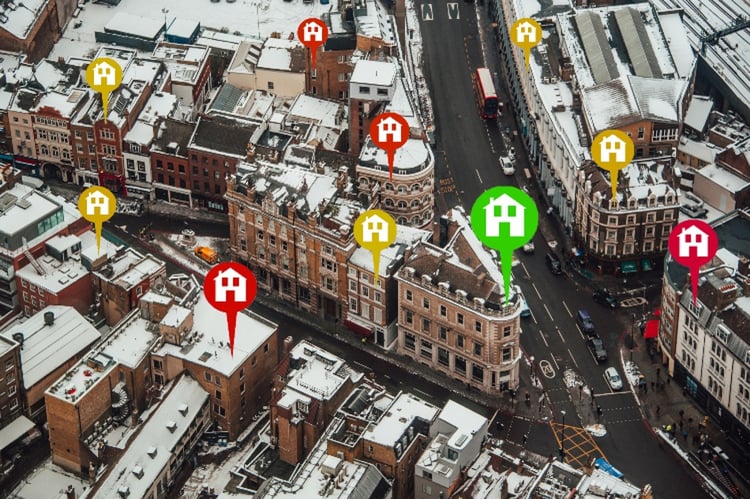Real estate moguls are among the wealthiest billionaires on the Forbes 400 list. Names like Donald Bren in California, H. Ross Perot Jr. in Texas, and Sam Zell in Chicago probably ring a bell. But take a look in the mirror. The next real estate mogul could be staring you right in the face.
Let’s explore how to work toward becoming a real estate mogul, even if you’re just considering buying your first investment property.
Key takeaways
- Many real estate moguls start out small and grow big by buying and holding single-family rental (SFR) properties.
- Real estate compounding is a strategy you might use to become a real estate mogul by reinvesting rental property cash flow.
- Steps for aspiring real estate moguls to follow include: educating yourself, building a team of real estate professionals, and selecting the best markets for growing your real estate portfolio.
How to work toward becoming a real estate mogul in 8 steps
While every aspiring real estate magnate takes a different path, here are 8 steps to help you get started.
1. Learn about real estate investing
They say knowledge is power, and that’s definitely true when it comes to real estate investing. The real estate business is constantly evolving, so real estate moguls never stop learning.
Ways to learn about real estate include reading real estate books and online blogs, networking with fellow investors, attending webinars and seminars, and taking online real estate classes. Roofstock Academy has membership plans designed to meet the needs and budgets of every real estate investor, including exclusive lectures and group and one-on-one coaching.
2. Create a business plan
The phrase “real estate mogul” means different things to different people. For example, one investor may focus more on cash flow than appreciation, while another may prefer to see a balanced blend of rental income and equity growth.
A good business plan includes small, actionable steps with investment goals and strategies and an overall financial plan. Take the time to ensure that every part of the business plan is SMART: specific, measurable, actionable, realistic, and timely.
3. Select an investing strategy
There are several different real estate investment strategies to choose from, and some investors use more than one:
- Buy and hold
- Reinvestment of rental income
- House hacking
- Buy-Remodel-Rent-Refinance-Repeat (BRRRR)
- Fix and flip
- Real estate wholesaling
- Real estate investment groups (REIGs)
- Real estate investment trusts (REITs)
- Crowdfunding
- Debt investing (private lending)
Of these 10 real estate investing strategies, buying and holding combined with reinvesting rental income is arguably one of the most effective ways to become a real estate mogul, as we’ll explain later in this article.
4. Choose the best real estate markets
There are hundreds of towns and cities in which to buy investment property, but some places are better for rental property than others. Some of the key factors that make a real estate market good for buying profitable rental property include:
- Strong job market and population growth
- Rent price increases and home value growth
- High percentage of housing units occupied by renters
- Number of active rental listings and vacant homes
- Desirable neighborhood characteristics
- Local amenities, such as easy access to shopping, dining, medical facilities, and parks
- Low property tax rates
- Climate, cost of living, and quality of life
5. Raise money for a down payment
The down payment for a rental property typically ranges between 20% and 25% of the purchase price. So, if a home is purchased for $120,000, the down payment would be between $24,000 and $30,000, excluding closing costs and money set aside in a reserve account to pay for emergency repairs and ownership costs during vacancies.
Here are some of the ways to raise money for the down payment on your first rental property:
- Personal savings (be sure to pay off high-interest debt first)
- Loans from family or friends
- Group investing by forming a real estate partnership or limited liability company (LLC)
- Converting a retirement account into a self-directed individual retirement account (SDIRA) for real estate
- Home equity line of credit (HELOC) to access the accrued equity in your primary residence
6. Analyze each deal in detail
Real estate investors aim to make money from rental property by collecting recurring rental income, profiting from the increase in equity appreciation, and using tax benefits like depreciation to reduce taxable net income.
However, while it may be possible to rent nearly any home, the truth is that some homes are better than others for renting, which is why crunching the numbers and analyzing each potential deal is so critical.
This simple spreadsheet by Roofstock provides an easy way to view the potential financial performance of a given property. You can use it to forecast the potential return of a property. Simply enter some information to view projected key return on investment (ROI) metrics, including cash flow, cash-on-cash return, net operating income, and cap rate.
7. Build a real estate team
Real estate is a team sport, and very few real estate moguls have gotten where they are today without the help of other people to lighten the workload and provide expertise. For example, many remote real estate investors hire local property managers to take care of properties and tenants, collect rent, manage maintenance requests, and ensure homes comply with local and state landlord-tenant laws.
Members typically found on a real estate team include:
- Investor-friendly real estate agent
- Mortgage broker or lender
- Real estate appraiser
- Escrow officer
- Home inspector
- Real estate lawyer
- Insurance broker
- Leasing agent
- Property manager
- Landscaper
- Pest control company
- Handyperson
- Licensed contractors
- Accountant or certified public accountant (CPA)
- Financial advisor
8. Buy your first rental property
Now it’s time to put all your time, effort, and hard work to good use by purchasing your first rental property. While it might be possible to find a home to rent out on the local multiple listing service (MLS) or online using a website like Realtor.com or Zillow, one of the best ways to buy your first rental property is by visiting an online platform specifically for real estate investors.
The Roofstock Marketplace lets everyone from first-time investors to global asset managers evaluate, purchase, and manage residential rental property. Since launching, buyers and sellers have completed more than $5 billion in transactions.
Each rental home listed for sale on Roofstock includes details about the property, rent payment history if the home is already rented to a tenant, and referral options for getting preapproved for a loan and hiring a local property manager after the transaction closes. The entire sale process can be done online, with assistance from the Roofstock transaction team, from offer to close of escrow.
Buying your first rental property could put you on the path to becoming a real estate mogul. Through the magic of real estate compounding, it’s possible to use the cash flow from one rental property to purchase many more.
Real estate compounding: From $0 to $1.3 million
Compounding real estate through reinvestment of cash flow is a tried and true strategy for aspiring real estate moguls. Compounding in real estate occurs when an investor rolls profits over from an initial investment to purchase another, and another, and another.
While the compounding strategy can be used at any stage of an investor’s career, it’s best to begin sooner rather than later. That’s because compounding works best when rental property is purchased and held for the long term.
Here’s an example of how real estate compounding works.
We’ll assume that home prices increase an average of 5% each year and that rent prices and operating expenses remain the same year over year. Home #1 is purchased for all cash. Over the years, additional homes have been acquired using cash-out refinancing to turn existing equity into cash for a down payment and personal savings.
| Year 1 | Year 5 | Year 10 | Year 15 | Year 20 | |
| Home #1 | $100,000 | $128,000 | $163,300 | $208,500 | $266,000 |
| Net Cash Flow | $4,800 | $24,000 | $48,000 | $72,000 | $96,000 |
| Home #2 | $128,000 | $163,300 | $208,500 | $266,000 | |
| Net Cash Flow | $2,600 | $13,000 | $26,000 | $39,000 | |
| Home #3 | $163,300 | $208,500 | $266,000 | ||
| Net Cash Flow | $3,300 | $16,500 | $33,000 | ||
| Home #4 | $208,500 | $266,000 | |||
| Net Cash Flow | $4,200 | $21,000 | |||
| Home #5 | $266,000 | ||||
| Net Cash Flow | $5,300 | ||||
| Total Cash Flows | $4,800 | $26,600 | $64,300 | $118,700 | $194,300 |
| Total Property Value | $100,000 | $256,000 | $489,900 | $834,000 | $1,330,000 |
| Year 1 | Year 5 | Year 10 | Year 15 | Year 20 | |
| Home #1 | $100,000 | $128,000 | $163,300 | $208,500 | $266,000 |
| Net Cash Flow | $4,800 | $24,000 | $48,000 | $72,000 | $96,000 |
| Home #2 | $128,000 | $163,300 | $208,500 | $266,000 | |
| Net Cash Flow | $2,600 | $13,000 | $26,000 | $39,000 | |
| Home #3 | $163,300 | $208,500 | $266,000 | ||
| Net Cash Flow | $3,300 | $16,500 | $33,000 | ||
| Home #4 | $208,500 | $266,000 | |||
| Net Cash Flow | $4,200 | $21,000 | |||
| Home #5 | $266,000 | ||||
| Net Cash Flow | $5,300 | ||||
| Total Cash Flows | $4,800 | $26,600 | $64,300 | $118,700 | $194,300 |
| Total Property Value | $100,000 | $256,000 | $489,900 | $834,000 | $1,330,000 |
At the end of 20 years, an investor would own rental property worth $1.3 million and have more than $194,000 in annual net cash flow. Of course, in the real world of real estate investing, income and expenses are never the same from one period to the next.
According to the Federal Reserve, the median sales price of houses sold in the U.S. has increased by just over 238%, while rent prices have increased an average of 8.86% each year since 1980, based on research from iPropertyManagement. However, there have also been periods when both home values and rent prices have declined.
Final thoughts
Most investors start out small with just one rental property, then gradually build up a rental property portfolio over time. While there are many ways to invest in real estate, focusing on SFRs is one of the best ways to become a real estate mogul. Homes can be easy to find, there are a wide variety of loan programs available, and many tenants prefer to live in single-family homes rather than apartment complexes.










